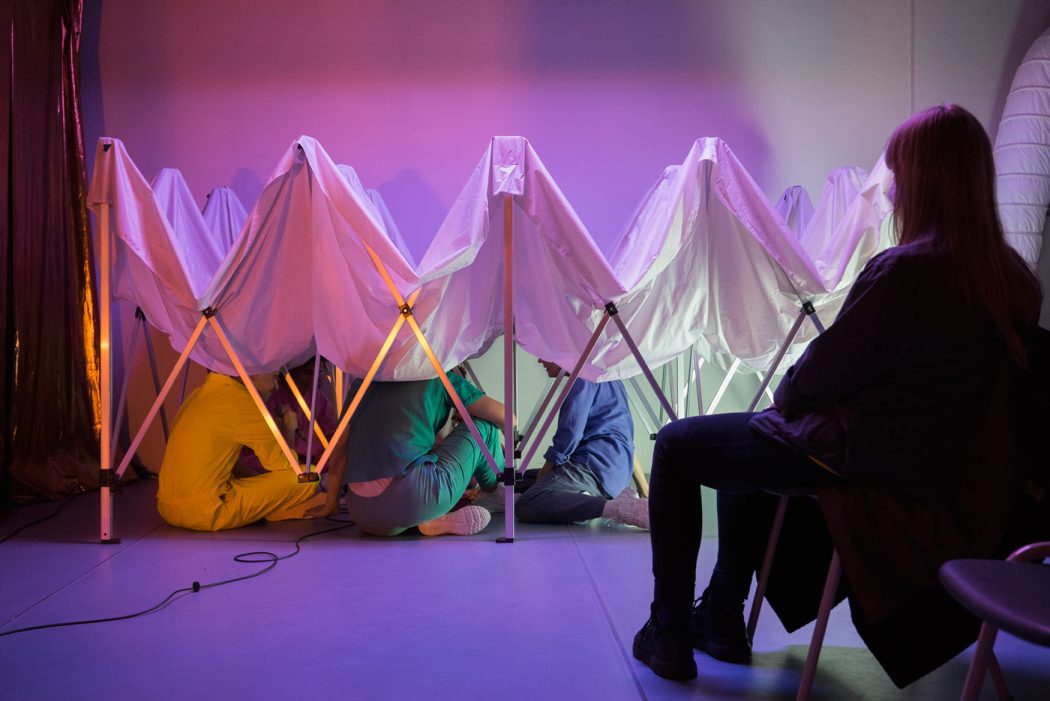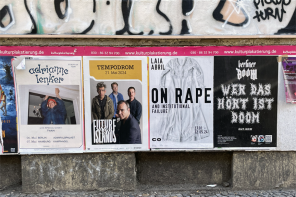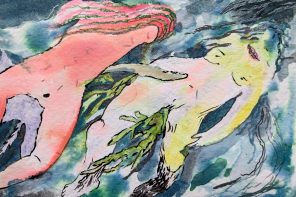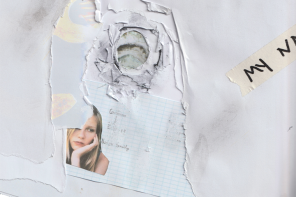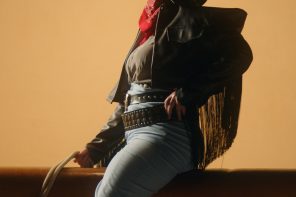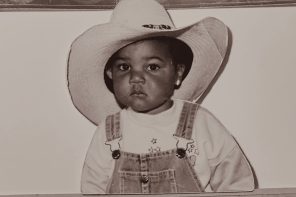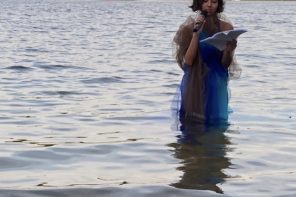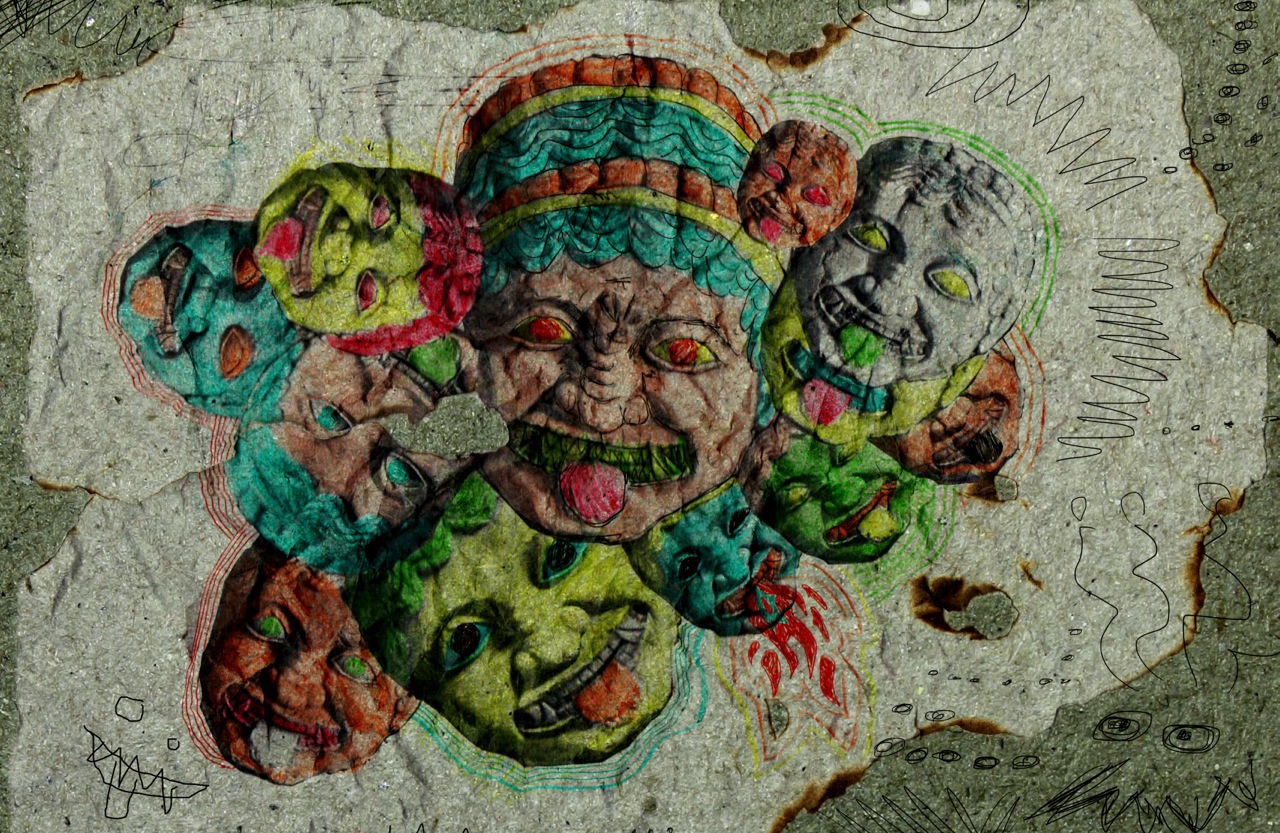Audio recording of the article
I’ve spent a lot of the last years in bogland – literal and metaphysical. For six years I obsessively returned to a river in Lancashire, (U.K.). I spent most of my time on top of the peat fells (big swathes of high altitude, boggy moorland with flat tops), looking for the source of small rivers that swell out of the wetland and spill down the cracks they make in the hillsides.
I can get scared on the fells. Suddenly sinking in thigh-deep, realising I am a five hour walk from another human, or a simple twisted ankle could make shit get serious. The bog puts you in your place, says you don’t know me that well, you cannot see from above what is happening below. It demands a certain intimacy and longterm commitment that cannot be bypassed. It’s bleak and specific. In many ways, I got stuck there long before the stickiness of a global pandemic. But I love lying on the springy mattress of the heather to keep dry, I love pressing my face into the wet muddy moss. Sometimes getting sucked into the earth is the most generative place to be.
These days I feel I’m still in the bogland, and I wonder if others are still here too. It seems there is movement around me but maybe it’s surface-level. I am still wedded to the underneath movement of the bog – not the drying up so we can walk on through – but the writhing and unnerving sense of transformation under the stagnant surface. It’s something entirely unimagined that comes out of nothing, but takes way longer than expected. Instead of bog-time, I feel we are out of time, some things speeding up and others lagging heavily behind. To be out of time, is to not know whether to loop back and pick up what you left, or run ahead and catch up with what has gone. To be out of time is to be neither ending nor beginning, to be outside the linear trajectory of narrative, and to be open to multi-directional vistas (including the detailed mud beneath your feet) rather than one horizon of arrival. How to trust the bog is a question, maybe, of rhythm.
I am busy with the bog-feeling as I begin to see performances again. The experience jolts me. I’ve been so long in the mud that I look up and momentarily lose track as to which moment we are in, remember and forget again, slip out of time, out of rhythm. Watching performances by newly-formed collective B-A-G both evokes this feeling and is an antidote to it. The collective takes its name from Ursula Le Guin’s Carrier Bag Theory of Fiction: an elsewhere and otherwise to the cis white man-given claim that story/life relies on Action, Hero, sticks, spears and swords that arise from the murky background of nothing-else-counting. Against the erasure of the day-to-day, multi-directional, multi-temporal being that the rest of us know life to be, Le Guin remembers that collecting, gathering, housing the food of life is not the backdrop for the main event, but the ongoing event (and story) itself.
The Carrier Bag Theory feels boggy and timely. We have collectively been thrust into the sidelines of the “action” – to make friends (or not) with the mundane, the domestic, the smaller spheres of influence, whilst gathering loved ones, support networks, repetitive acts that make the day sustainable. What story gets carried out from this unspectacular place, feels like a question B-A-G is carefully busy with. Like Le Guin, such questions bring different kinds of labor, care, and attention into visibility and value, and with them the bodies that inhabit such practises and rhythms.
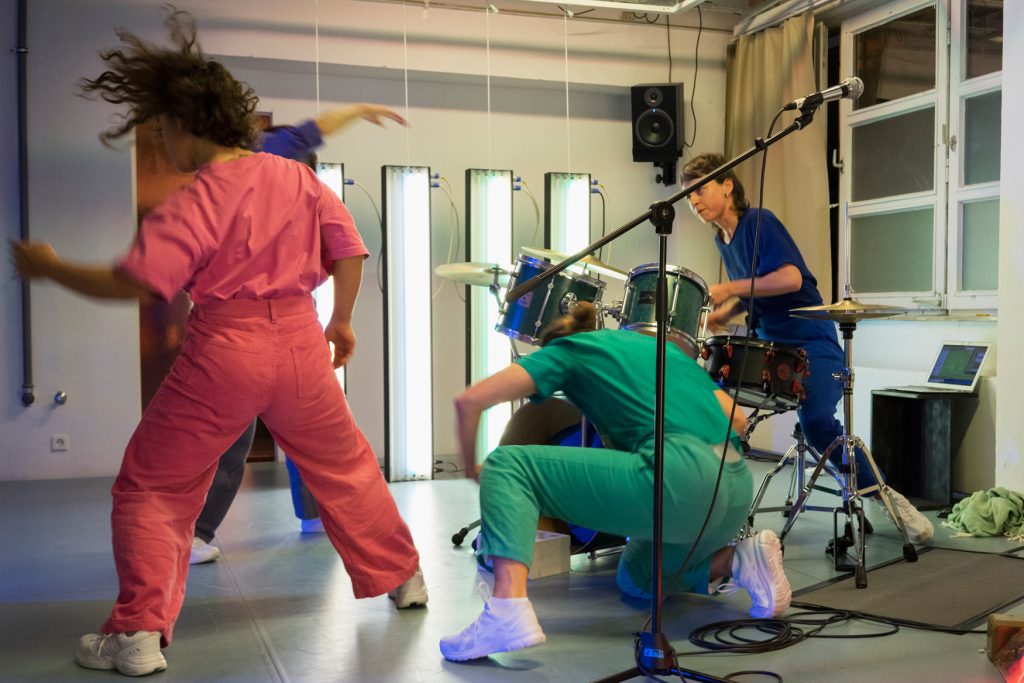
B-A-G has been working somewhat nomadically across different “stations” for the last few months – Marzahn community centre, the rural village of Wahrenberg, FELD with teenage groups (where one performance was staged), and another at Vierte Welt. Self-described as a “wandering circus,” the group asks what tools they might have to offer in their encounters with different communities. How to be porous to these encounters, simultaneously present to what is needed in the moment of them, as well as remaining committed to carrying their resonances and shaping them on the stage? Straddling these roles demands that the performer-as-carrier walks a fine line. She must respect that not everything might be available to be picked up and taken to another context or audience.
The End is Not an Option navigates this by emerging as part gathering, part collection of activities, part teenage sleepover, and part pop-punk-band concert; it is playful and sincere in its dealing with the “future anxiety” so amplified by climate crisis and global pandemic. Fragments of story ripple out horizontally. Activities that might otherwise be on the periphery of the “work” get discussed as the work itself: cooking, making songs, sharing beds, working conditions. So too does the undramatic failure of these activities, like when nobody turned up, when a common language was not found, when we did not agree. However, the rhythm of these moments is not the undifferentiated sonic mulch of the bog (paradoxically the breeding ground for differentiated emergence). I still witness six discreet bodies, dressed each in a different block color, forming the promise of cohesion with difference. And when the group disperses and breaks into song, the frame of the “band” in which you literally have to be “in time” with one another continues this promise of collective rhythm.
“WHYyyy” the lead singer refrains, whilst the others fill in the rest of the question “why… can’t we… stop using plastic… why can’t we… slow down…” The scale of the questions are out of joint (they could be nothing else) with the punk/pop vibe, but it’s not ironic. There’s a sincerity and childlike or teenage quality that gets amplified by the rest of the work and begins to queer its rhythm. The group goes on to discuss their first childhood memories of being aware of issues to do with “the environment.” Later they ask each other how long a lunch-break they need whilst working. There are no answers, no solutions, no promises that needs will be met. It’s a kind of carrier bag moment; the centre remains spacious. Although the aesthetics, sound, and movement quality of the performance are not at all boggy, by the end I’m in a weirdly comfortable (for my current state) out-of-timeness. For a piece dedicated to the question of the future, I’m relieved to find myself suspended.
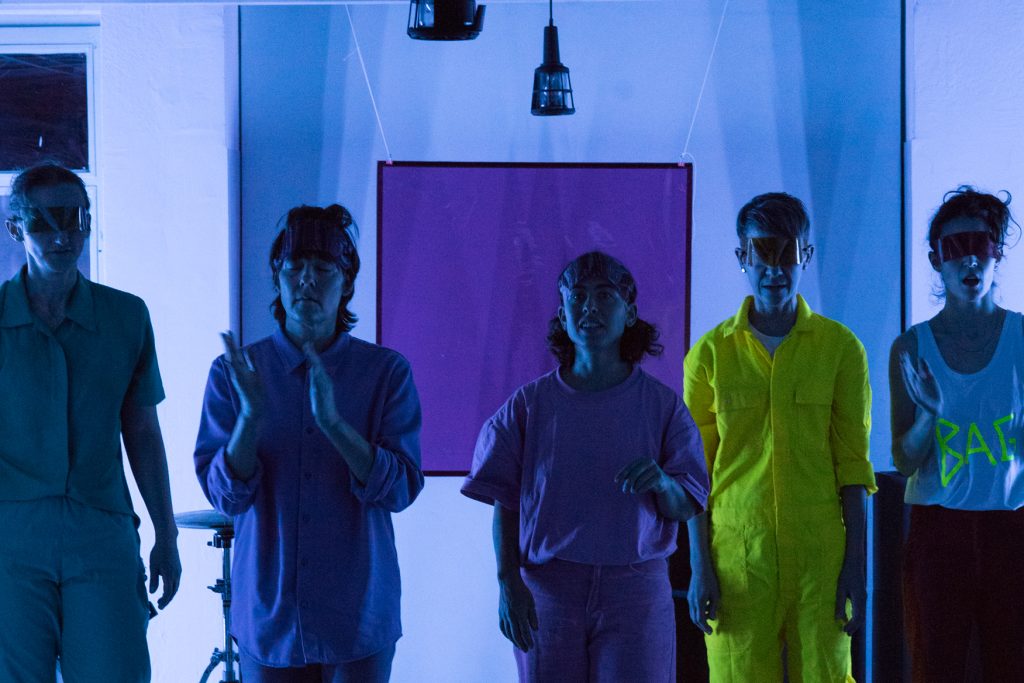
Within a familiar promise of the “collective” – individuals coming together across (relative) differences – which to me holds a certain promise of linear time, rhythm, and futurity, something has managed to leak out. On the cusp of an ending, the performers begin to slip out, one-by-one, from under a tent-like structure where they’ve been huddled. Each takes an object and begins tapping at the walls, the floor, the corners of the theatre – the (infra-)structure itself. They seem to be listening to the quality of texture that tells you what’s beyond the visible, what’s underneath, what’s breakable. The tapping creates a kind of swarming in the space, an arbitrary path-making, a spillage – that which cannot be contained by its function overflows into new shapes, new futures – leaking into what Bayo Akomolafe calls the “cracks.”
The tapping escalates into a final band moment, but this time each performer holds a distinct rhythm I later find out is morse code. Each one is so focused on their code, so alone and alongside, and this futile score is so weirdly “out of time” it is mesmerising. When nobody is on the other side of this code (least of all the audience) then it’s “doing something” is in the out-of-time buzz left in the wake of its call. In this moment, rhythm is not the punctual, predictable (as in, harmony) in-timeness of the band, or actions that mark out a life, but something that breaks out of the continuous, known trajectory towards a future. It makes me feel rhythm as something in excess of time: the vertical speed of light, cutting through the horizontal speed of matter/body. And what if this actually makes a crack, a fissure for the water to spill into and out of, and in the spillage a flood plain gathers, held in the vessel and contours of the land: a bog, a marshland, a fecund decomposition. Is this the rhythm of the bog? The End is Not an Option pulses in the suspension of this encounter between times, communities, the mundane and the global, anxieties and non-answers. I could stay for a long time, which is to say, something is held out-of-time, with no promise of an end.
Laura is an interdisciplinary artist exploring the material-spiritual encounter between human and more-than-human presences. Her research asks how earth-emergent pedagogies, and devotion, intersect with transformative justice and abolitionist futures. She holds a PhD in Fine Art from Goldsmiths University, which tracks her vocal practice in relation to the River Wyre, its witch-hunt history, alchemical river stones, personal ancestries of mental health and the entanglements of this history with white settler colonialism.

